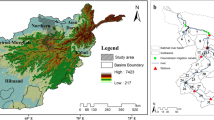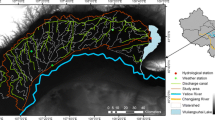Abstract
The Aksu River is a principal headwater tributary of the Tarim River in northwest China providing 70–80 % of its water supply. This study aims to simulate the impact of potential future irrigation and cropping schemes on river discharge in the semi-arid and irrigation intensive part of the Aksu River basin. To achieve this goal, the eco-hydrological model SWIM (Soil and Water Integrated Model) was developed further by including an irrigation module and a river transmission losses module. The performance of the SWIM model in the region was then compared with that of another water management model, WEAP (Water Evaluation And Planning). The results show that both models are capable of reproducing the monthly discharge at the downstream gauge well using the local irrigation information and the observed upstream inflow discharges as inputs. Still, the SWIM model performs better than the WEAP model because it accounts for both hydrological processes and agricultural impacts. Therefore, SWIM was used for the scenario study. Different irrigation scenarios were developed based on the recent trends of agricultural practices. The study showed that the improvement of irrigation efficiency was the most effective measure for reducing irrigation water consumption and increasing river discharge downstream. The expansion of irrigation area in the basin leads to an increase in water consumption while the changes in crop structure (composition of crop types) on arable land do not have significant impact on the river discharge downstream.





Similar content being viewed by others
References
Arnold JG, Allen PM, Bernhardt G (1993) A comprehensive surface-groundwater flow model. J Hydrol 142:47–69
Aus der Beek T, Voß F, Flörke M (2011) Modelling the impact of global change on the hydrological system of the Aral Sea basin. Phys Chem Earth 36:684–695
Dechmi F, Burguete J, Skhiri A (2012) SWAT application in intensive irrigation systems: model modification, calibration and validation. J Hydrol 470–471:227–238
Droogers P, Immerzeel WW, Terink W, Hoogeveen J, Bierkens MFP, van Beek LPH, Debele B (2012) Water resources trends in Middle East and North Africa towards 2050. Hydrol Earth Syst Sci 16:3101–3314
FAO, IIASA, ISRIC, ISSCAS, JRC (2012) Harmonized World Soil Database (version 1.2). FAO, Rome, Italy and IIASA, Laxenburg, Austria
Farr TG, Rosen PA, Caro E, Crippen R, Duren R, Hensley S, Kobrick M, Paller M (2007) The shuttle radar topography mission. Rev Geophys 45:RG2004. doi:10.1029/2005RG000183
Güntner A, Bronstert A (2004) Representation of landscape variability and lateral redistribution processes for large-scale hydrological modelling in semi-arid areas. J Hydrol 297(1–4):136–161
Hacker F (2005) Model for water availability in semi-arid environments (WASA): estimation of transmission losses by infiltration at rivers in the semi-arid Federal State of Ceará (Brazil). http://brandenburg.geoecology.uni-potsdam.de/projekte/sesam/download/abstracts/Studienarbeit_FlorianHacker_finalVersion.pdf. Accessed 18 July 2013
Harma KJ, Johnson MS, Cohen SJ (2012) Future water supply and demand in the Okanagan Basin, British Columbia: a scenario-based analysis of multiple, interacting stressors. Water Resour Manag 26(3):667–689
Hughes DA (2008) Modelling semi-arid and arid hydrology and water resources: the southern African experience. In: Wheater H, Sorooshian S, Sharma KD (eds) Hydrological modelling in arid and semi-arid areas. Cambridge University Press, Cambridge, pp 29–40
Krysanova V, Wechsung F (2000) SWIM (soil and water integrated model) user manual. http://www.pik-potsdam.de/members/valen/swim. Accessed 18 July 2013
Krysanova V, Meiner A, Roosaare J, Vasilyev A (1989) Simulation modelling of the coastal waters pollution from agricultural watersheds. Ecol Model 49:7–29
Krysanova V, Möller-Wohlfeil D, Becker A (1998) Development and test of a spatially distributed hydrological / water quality model for mesoscale watersheds. Ecol Model 106:261–289
Lane LJ (1990) Transmission losses, flood peaks and groundwater recharge. Hydraulics/hydrology of arid lands (H2AL): proceedings of the International Society of Civil Engineers, Hydraulics Division
Lei Z, Zhen B, Shang S, Yang S, Cong Z, Zhang F, Mao X, Zhou H (2001) Formation and utilization of water resources of Tarim River. Sci China 44(6):615–624
Leopold LB (1994) A view of the river. Harvard University Press, Cambridge, 298pp
Liang J, Li Y, Zhang XH, Zhang J, Li TB, Wang ST, Shen JD (2003) An analysis of groundwater resource and water – salt control in Akesu area. J Jilin Univ (Earth Sci Ed) 33(2):192–196
Mtalip T, Yang HM, Zhao XF (2009) Discussion on current situation of water resource in the upper reaches of the Tarim River Mainstream. Environ Prot Xinjiang 31(3):6–9
SEI (2005) WEAP water evaluation and planning system. Stockholm Environment Institute, USA
Tang Q, Hu H, Oki T, Tian F (2007) Water balance within intensively cultivated alluvial plain in an arid environment. Water Resour Manag 21(10):1703–1715
Tornqvist R, Jarsjo J (2012) Water Savings through improved irrigation techniques: basin-scale quantification in semi-arid environments. Water Resour Manag 26(4):949–962
Wang Y (ed) (2006) Local records of the Akesu River Basin. Fangzhi Publisher, China
Weedon GP, Gomes S, Viterbo P, Shuttleworth WJ, Blyth E, Österle H, Adam JC, Bellouin O, Best M (2011) Creation of the WATCH forcing data and its use to assess global and regional reference crop evaporation over land during the twentieth century. J Hydrometeorol 12:823–848. doi:10.1175/2011JHM1369.1
Wortmann M, Krysanova V, Kundzewicz ZW, Su B, Li X (2013) Assessing the influence of the Merzbacher Lake outburst floods on discharge using the hydrological model SWIM in the Aksu headwaters, Kyrgyzstan/NW China. Hydrol Process, accepted
Xu H, Ye M, Li J (2008) The water transfer effects on agricultural development in the lower Tarim River, Xinjiang of China. Agric Water Manag 95:59–68
Yang Q, He Q (2003) Interrelationship of climate change, runoff and human activities in Tarim River basin. J Appl Meteorol Sci 14(3):309–321 (in Chinese with English abstract)
Zhang X, Yang D, Xiang X, Huang X (2012) Impact of agricultural development on variation in surface runoff in arid regions: a case of the Aksu River Basin. J Arid Land 4(4):399–410
Acknowledgments
The study was financially supported by the German Ministry for Research and Education (BMBF), within the project Sustainable Management of River Oases along the Tarim River/China (SuMaRiO, Code: 01 LL 0918). It was also supported by The National Basic Research Program of China (973 program) (No. 2012CB955903).
Author information
Authors and Affiliations
Corresponding author
Electronic supplementary material
Below is the link to the electronic supplementary material.
ESM 1
(DOC 27 kb)
Rights and permissions
About this article
Cite this article
Huang, S., Krysanova, V., Zhai, J. et al. Impact of Intensive Irrigation Activities on River Discharge Under Agricultural Scenarios in the Semi-Arid Aksu River Basin, Northwest China. Water Resour Manage 29, 945–959 (2015). https://doi.org/10.1007/s11269-014-0853-2
Received:
Accepted:
Published:
Issue Date:
DOI: https://doi.org/10.1007/s11269-014-0853-2




